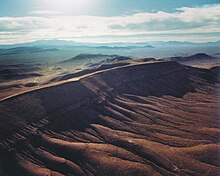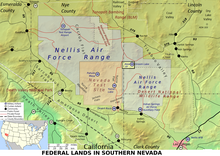Yucca Mountain
Yucca Mountain is a flat ridge in the US state of Nevada that extends nearly 6 miles from south to north. The region has a desert climate with little rainfall. The area is on the traditional land of the Western Shoshone Indians , to whom the area is sacred. Yucca Montain is being considered as a repository for radioactive waste .
geology
The ridge is in the Mojave Desert . The elevation consists of pyroclastic sediments , initially the remains of a large lava flow from the Miocene , overlaid by tuff from the nearby Nevada volcanic group. The area has geological faults mostly in a south-north direction . The repository would be placed 280 m below the surface in Topopah Spring Tuff.
Use as a storage facility for radioactive waste
Yucca Mountain has been selected as the prospective site for a spent fuel and high level radioactive waste repository . Originally, the best location for the further investigations was to be selected from three location alternatives by means of a comparative assessment. This process was stopped, however, and Yucca Mountain was designated as the only repository site to be investigated by the federal government. Plans envisaged a storage capacity of around 77,000 tons of radioactive waste, including 63,000 tons of spent fuel elements from commercial nuclear power plants , the remainder being spent fuel elements from military reactors and vitrified high-level radioactive waste from the military reprocessing plants of the Department of Energy (DOE).
The planned emplacement field is between 200 and 425 m below the surface. The host rock is volcanic tuff . According to the stopped plans, the repository should consist of large underground cavities with a large number of connecting tunnels in which the waste is stored. The delivered material is unloaded from the transport containers and transferred to sealed final storage containers. These are stored horizontally in the tunnel. The DOE is currently investigating the effectiveness of various technical barriers.
Development after 2008
The suitability and use of Yucca Mountain as a nuclear waste repository is controversial. In particular, future climate changes (damp climate instead of desert climate), earthquakes and volcanic eruptions are considered to be possible dangers for the repository. Politically, all US states - with the exception of Nevada - are in favor of a repository in Yucca Mountain. This would have the advantage that the eastern federal states in particular, where the majority of nuclear power plants are located, could dispose of their radioactive waste there. For years the Western Shoshone have been fighting in association with national environmental protection organizations to stop the project. In 2002 the government under President George W. Bush decided to set up the repository despite numerous negative environmental studies and against the protests of the indigenous peoples . In 2008, the United States Department of Energy issued the official resolution and the Nuclear Regulatory Commission began preparing the technical evaluation.
Immediately after US President Barack Obama took office in February 2009, however, the project was temporarily stopped because the earthquake risks in the region around Yucca Mountain were reassessed. In addition, the amount of waste to be disposed of in the US has been greater than the previously permitted capacity for Yucca Mountain since at least 2011. In 2012, an independent commission set up by the president recommended starting the search for a repository from scratch. In particular, regions should be searched for that voluntarily declare themselves willing to accept the repository. An interim storage facility is to be built for the interim period. Yucca Mountain could reapply as a location in the process.
In 2013, a federal court ruled that the Nuclear Regulatory Commission was obliged to complete the technical evaluation even if the government did not want to continue the process. In January 2015, the Nuclear Regulatory Commission submitted the five-part report and came to the conclusion that, from a technical point of view, a repository in Yucca Mountain is suitable according to the draft plans. In contrast, the draft of the US federal budget drawn up in February 2015 no longer provides funds for Yucca Mountain. After the 114th Congress of the United States has a majority of the Republican Party in both houses , and this supports Yucca Mountain, the political decision is considered open (as of February 2015). The use as a repository met with resistance from the two senators from Nevada. An earthquake with a magnitude of 7.1 on July 4, 2019 in Ridgecrest, which is not too far away , also raised doubts about safety .
Yucca Mountain was the starting point for an investigation into atomic semiotics .
literature
- Marc Strout: Wasteland: the 50-year battle to entomb our toxic nuclear remains. In: The Verge . June 14, 2012 ( theverge.com ).
Web links
- Helen Wallace (for Greenpeace International): Rock Solid? A scientfic review of geological disposal of high-level radioactive waste. September 2010, PDF, 67 pages
Individual evidence
- ↑ a b c Emma Snaith, Earthquakes repeatedly striking proposed US nuclear waste site , The Independent, July 19, 2019.
- ↑ William R. Keefer, John W. Whitney, David C. Buesch, Geology of the Yucca Mountain site area, southwestern Nevada , January 2007, DOI https://doi.org/10.1130/2007.1199(03) .
- ↑ Bloomberg , Obama Rejects Nuclear Waste Site After 20-Year Fight . February 26, 2009.
- ↑ dradio.de
- ↑ Safety review for Yucca Mountain site released. In: nature. January 29, 2015.
Coordinates: 36 ° 51 ′ 10 " N , 116 ° 25 ′ 36" W.


